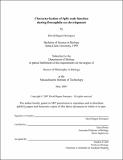Characterization of split ends function during Drosophila eye development
Author(s)
Doroquez, David Bagon
DownloadFull printable version (11.27Mb)
Alternative title
Characterization of Spen function during Drosophila eye development
Other Contributors
Massachusetts Institute of Technology. Dept. of Biology.
Advisor
Ilaria Rebay.
Terms of use
Metadata
Show full item recordAbstract
Conserved signal transduction pathways coordinate all aspects of metazoan development, including cell fate specification, differentiation, and growth. Rather than functioning as completely independent modules, signaling pathways interface to create a web of specific interactions that a cell integrates in a spatial and temporal manner. The Epidermal Growth Factor Receptor (EGFR) and Notch pathways are evolutionarily conserved signal transduction mechanisms that interact intimately to regulate a broad spectrum of developmental processes in metazoa. The molecular bases underlying cross-talk and signal integration between these two pathways are just beginning to be elucidated. In this thesis, we have focused on the role of Split ends (Spen), the founding member of a family of transcriptional co-repressors, as a node of cross-talk between the EGFR and Notch signaling pathways during Drosophila eye development. At the morphogenetic furrow (MF), which marks the wave of differentiation that passes through the imaginal disc eye primordium, Notch signaling is required for establishing and refining the expression of proneural Atonal (Ato). Ato promotes the EGFR pathway's reiterative signaling for progressive and sequential recruitment of cells within each ommatidial facet of the eye. (cont.) Previous studies found that spen functioned within or in parallel to the EGFR pathway during midline glial cell development in the embryonic central nervous system. In vertebrates, Spen orthologs function in repressor complexes that antagonize the transcription of Notch pathway targets. The involvement of Spen proteins in EGFR and Notch signaling in these systems thus motivated us to explore the consequences of loss of spen function with respect to each pathway during eye development. Here we report that Spen acts as both a positive regulator of EGFR signaling and as an antagonist of Notch signaling in the eye. We find that loss of spen results in hyper-activation of the Notch pathway via upregulation of the Notch activator Scabrous. This results in loss of Ato and activated MAP kinase at the MF, therefore antagonizing output from the EGFR signaling pathway. As a consequence, there is a failure of cell fate specification in spen mutant ommatidia. These observations suggest that Spen modulates output from the Notch and EGFR pathways to ensure appropriate patterning during eye development. Additionally, we have characterized a transgene encoding nuclear localization sequence-tagged Spen C-terminus that functions as a dominant-negative (SpenDN). (cont.) The Spen C-terminus contains the evolutionarily conserved SPOC domain that is required for transcriptional repression. In order to identify components related to Spen function and to understand the processes in which Spen may be involved, we performed a genetic screen to identify dominant modifiers of the rough-eye associated with eye-expressed SpenDN. Our results confirm interactions with the EGFR and Notch pathways, but also suggest functions for Spen in chromatin regulation and programmed cell death. As Spen-like proteins are involved in human development and disease, it will be important to elucidate the underlying molecular mechanism behind Spen function.
Description
Thesis (Ph. D.)--Massachusetts Institute of Technology, Dept. of Biology, 2007. This electronic version was submitted by the student author. The certified thesis is available in the Institute Archives and Special Collections. Pages 327-328 blank. Includes bibliographical references.
Date issued
2007Department
Massachusetts Institute of Technology. Department of BiologyPublisher
Massachusetts Institute of Technology
Keywords
Biology.